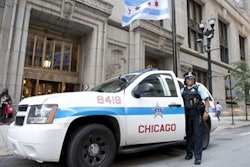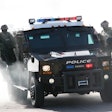 Photo courtesy of Lynne Doucette.
Photo courtesy of Lynne Doucette.
Those of us living and patrolling in the northeast understand the dangers of moose in the roadway. An adult moose can weigh up to 1,500 pounds and stand up to 7 feet tall. So it's no surprise that a collision with one can be deadly.
It was early Saturday morning, around 3:15 a.m. on June 16, when one of my officers was called to assist the state police in locating Maine's largest animal, the moose, on Interstate 295. This type of call is a public safety concern because of the potential of dangerous crashes—a concern I would soon understand all too well.
My town's access to the interstate is located in the middle of a 4-mile stretch of highway between the two outlying jurisdictions. I entered the highway, and drove south at 35-40 mph, searching the double-lane roadway with my spotlight. I scanned back and forth with the light, looking for the animal. I covered 2 miles on either side of where the moose had been reportedly seen. I ultimately cleared the call, believing the moose had returned to the woods on its own. I turned off my spotlight and accelerated to highway speed, at 70-75 mph.
After driving another mile, I suddenly observed four large, gangly brown legs come into my headlight beams. I had enough time to process what it was, and the thought of "I'm f*%$ed" passed through my brain. I came down heavy on the brakes and swerved hard to my left. I heard the sounds of the animal crashing into the metal of the car and breaking glass. My world was closing in on me. When the sounds stopped and I knew my vehicle was no longer moving, I took stock of the situation and couldn't believe I was alive. Moose crashes in Maine often end with the occupants seriously injured or worse; they are fatalities.
"10-50! 10-50 (meaning "police vehicle involved in an accident" in my jurisdiction)," I transmitted to dispatch, while I reached down for my emergency lights and turned them on. The last thing I wanted was to be hit by another car from behind.
At that point, I felt the adrenaline dump. Having been a cop for 15 years, I knew what it was and tried to control it the best I could. I took two deep breaths and exhaled slowly, trying to stay calm. I felt my heart pounding out of my chest, and my hands were starting to shake.
I realized my head was pounding—the worst headache I've ever had—and my neck was stiff. I also felt some abrasions from the glass shattering on my right elbow. I was covered in glass and hair, and I kept spitting glass dust from my mouth, but I survived the crash unscathed. I sat in disbelief that I wasn't badly hurt—thankful, but still amazed. Sadly, the moose was killed.
A moose's body stands taller than most car hoods, making them a real threat to occupants in crashes. If you collide with a moose at high speeds, the bumper and front grille will break the moose's legs, causing the body to fall onto the hood and delivering the bulk of the animal's weight into the windshield. Usually, this will crush the front roof support beams and anyone in the front seats. Collisions of this type are frequently lethal; seatbelts offer no protection from the crushing weight of the animal. Because the bulk of the collision is at the windshield or higher the airbags may not deploy.
As I looked around the interior of my car after the crash, I couldn't believe what I was seeing. The windshield was smashed and hanging inside the car. The roof was crumpled back to the front of my lightbar, and it was caved in at an angle just 6 inches from my head. There I sat, in the only small area of the passenger's compartment that was still intact.
It felt like an eternity—in real time it was about 60 seconds—until I saw blue lights approaching. It was the most comforting feeling, seeing a brother in blue arrive. It gave me comfort knowing he had control of what I suspected was a horrific scene, and knowing he would handle it just fine in my absence.
This is surely an experience I will never forget.
Lt. Lynne D. Doucette is a patrol supervisor and defensive tactics trainer with the Brunswick (Maine) P.D.





















